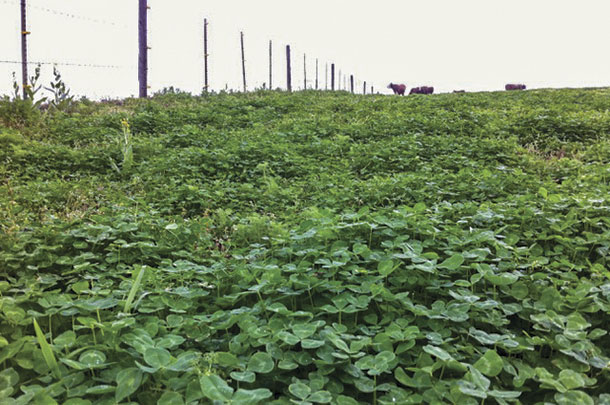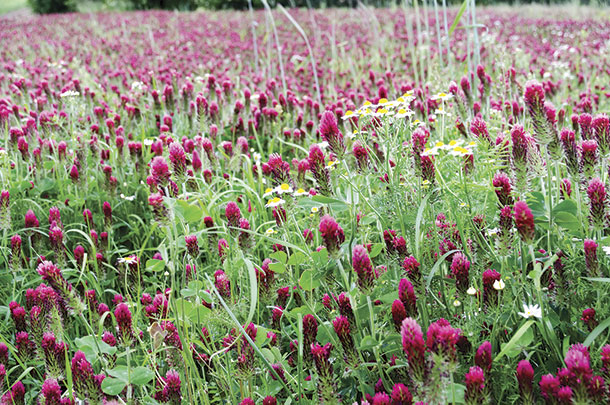Forage plant improvement programs in ryegrass, small grains and forage legumes have been and continue to be an integral part of beef production research.The Texas A&M AgriLife Research and Extension Center at Overton (ARECO) is uniquely located in the Pineywoods eco-region of northeast Texas and, in a broader view, is on the western edge of the Coastal Plain region of the southern U.S.
The soils are generally sandy, acid and infertile, and in combination with a 45-inch average rainfall, provide a similar climate to that across the U.S. southern region. Included here are some of the breeding projects researched in this climate.
Breeding programs
-
Annual ryegrass and small grain – ‘TAM90’ annual ryegrass (Lolium multiflorum Lam.) was released 23 years ago and remains a standard among ryegrass cultivars. Recent cultivars released from this program include Nelson and TAMTBO ryegrass.
‘Bradford’ wheat (Triticum aestivum L.) was developed at Overton and released as a dual-purpose forage/grain cultivar. ‘Bates’ forage rye (Secale cereale L.) was a cooperative release with Noble Foundation, Ardmore, Oklahoma. In 2016-17, 53 forage ryegrass cultivars and experimental lines were evaluated at Overton.
-
Arrowleaf clover – Arrowleaf clover (Trifolium vesiculosum Savi) is a robust, high-yielding annual clover that is well adapted as an overseeding component of perennial warm-season grass forage systems used across the U.S. southern region. This clover is productive later in the spring (March to June) contrasted to crimson clover (Trifolium incarnatum L.), which flowers and ceases growth in mid-April.
Arrowleaf clover was widely used in the U.S. southern region in the 1960s and 1970s. Various disease and pest problems were reported on arrowleaf clover, and forage production from the varieties Yuchi, Amclo and Meechee was unreliable by the late 1970s. A breeding program was initiated at ARECO in 1979 to develop improved, disease-resistant arrowleaf clover cultivars.
Apache arrowleaf clover was developed for tolerance to bean yellow mosaic virus and was released in 2000. Plant Variety Protection status was granted in 2005. The bean yellow mosaic virus tolerance of Apache has restored the utility of arrowleaf clover in livestock production systems.
Fungal pathogens in the soil can also attack arrowleaf clover and cause damage at different growth stages. Pythium ultimum, P. irregular, Rhizocotonia solani AG4 and Fusarium poliferatum were shown to infect, kill or damage germinating seed and emerging seedlings of arrowleaf clover.
Pythium ultimum was noted to cause particularly severe symptoms, often resulting in 100 percent death of arrowleaf clover seedlings. A seedling screening method was developed to assist in selection and breeding of arrowleaf clover for tolerance to this fungal pathogen.
Blackhawk arrowleaf clover was developed for tolerance to the fungal soil pathogen Pythium ultimum and for tolerance to bean yellow mosaic virus. This new arrowleaf clover cultivar was released as a cultivar in 2013. The origin of this line traces back to dark-seeded half-sib lines from arrowleaf cultivars Yuchi, Amclo and Meechee.
 Blackhawk seeds are 95 percent black with only slight variation in degree of dark color. The black seed coat of Blackhawk arrowleaf has been associated with tolerance to Pythium ultimum in our trials, and further research is in progress to determine the genetics of this seed coat color trait.
Blackhawk seeds are 95 percent black with only slight variation in degree of dark color. The black seed coat of Blackhawk arrowleaf has been associated with tolerance to Pythium ultimum in our trials, and further research is in progress to determine the genetics of this seed coat color trait.
- White clover – White clover (Trifolium repens L.) originated in the Mediterranean region but has been widely distributed and is now naturalized on every continent. This clover species is widely grown in the eastern U.S. and is grown as a seed crop in the northeast U.S. White clover is a self-sterile, cross-pollinated, highly variable tetraploid species.

In the Coastal Plain region of the lower south U.S. (east Texas, Louisiana, south Mississippi, south Alabama, south Georgia and Florida) the combinations of climate and soil conditions often prevent white clover from persisting as a perennial. White clover is well adapted to bottomland clay and clay loam soils with moderate to poor drainage in this region and will persist on these sites through reseeding.
This clover may also survive and live as a perennial in some years if summer rainfall is abundant. The large white clover types require long day lengths (12 to 16 hours) for optimum flowering and never flower profusely in this region. Intermediate white clover types flower earlier and produce seed earlier, thus taking advantage of the spring rainfall and temperatures in the lower South.
White clover cultivars that flower early and have good forage production traits are needed for this region to improve reliability of this forage legume.
Neches is a new cultivar of white clover (Trifolium repens L.) released in January 2010. Neches is a synthetic variety of intermediate white clover with 147 parent plants selected for early and profuse flowering in combination with moderate leaf size and high potential forage production.
The parentage of Neches is highly diverse, including plant introduction lines from Uruguay and Israel, local ecotypes from east Texas and pest-resistant germplasm developed by USDA-ARS in Mississippi. Neches combines early flowering and seed production with high forage yield and is broadly adapted on loamy bottomland soils from east Texas across the entire Southern region.
-
Crimson clover – Crimson clover (Trifolium incarnatum L.) is one of the most widely used cool-season annual clovers in the U.S. because of its good seedling vigor, early forage production and reseeding potential. Crimson clover is primarily used in the southeastern U.S. to overseed warm-season perennial grasses and extend the grazing season.
The currently available crimson clover cultivars flower and seed mature about 14 days earlier than annual ryegrass. When ryegrass-crimson clover mixtures are managed for clover reseeding (cattle removed about April 15), several weeks of ryegrass grazing are lost. If the same mixtures are grazed until late April, the crimson clover will not recover and produce seed.

Sabine is a new cultivar of crimson clover selected for late flowering and improved hard seed levels. Recurrent selection was used to shift flowering date and to improve hard seed production and reseeding. Sabine flowers about 10 days later than Dixie crimson, allowing a better match to ryegrass in grazing management systems. Sabine crimson has a much higher hard seed level and corresponding improved ability to build a soil seed bank compared to Dixie and Tibbee crimson.
-
Sweetclover – Annual white sweetclover (Melilotus albus Medik.) is a forage legume that has been used for pasture, hay and soil improvement, and is very well adapted to the blackland and prairie soils of the southern Great Plains that extend through central Texas. Sweetclover was used widely in central Texas prior to the 1950s, when inexpensive nitrogen fertilizer reduced the use of all forage legumes.
Breeding programs are in progress at Overton to develop improved annual sweetclover for Texas with reduced toxicity concerns in combination with disease resistance. Our first sweetclover cultivar, Silver River, has a high level of rust resistance and is well adapted to south and central Texas.
-
Lablab bean – Lablab (Lablab purpureus [L.] Sweet) is a vining, herbaceous tropical legume with high nutritive value as a forage or browse for ruminant animals. The qualities of this tropical forage include: drought tolerance, high palatability, high nutritive value, excellent forage yields and adaptation to diverse environmental conditions.
Rio Verde lablab was developed for tolerance to defoliation, forage production potential and Texas seed production. Rio Verde is the first lablab cultivar developed in the U.S. Seed production of this cultivar is limited in Texas by leaf and stem blight caused by anthracnose (colletotrichum spp.). Anthracnose-resistant lablab germplasm has been identified, and new cultivar development is in progress.
Other breeding projects include rose clover (Trifolium hirtum All.) and forage cowpea (Vigna unguiculata [L.] Walp.), both with great genetic potential to develop improved forage types. ![]()
PHOTO 1: A researcher is surrounded with pollinators in a seed production field of Silver River sweetclover in western Oklahoma. Photo by Adam Russell, Texas A&M AgriLife Extension.
PHOTO 2: Blackhawk arrowleaf clover is shown in a grazing trial at Overton, Texas. Photo by Gerald Smith.
PHOTO 3: White Clover.
PHOTO 4: Crimson Clover. Photos by Getty Images.
F.M. Rouquette Jr. is with the Texas A&M AgriLife Research and Extension Center at Overton.
References omitted but are available upon request. Click here to email an editor.
Gerald R. Smith is with Texas A&M AgriLife Research. Email Gerald R. Smith.












